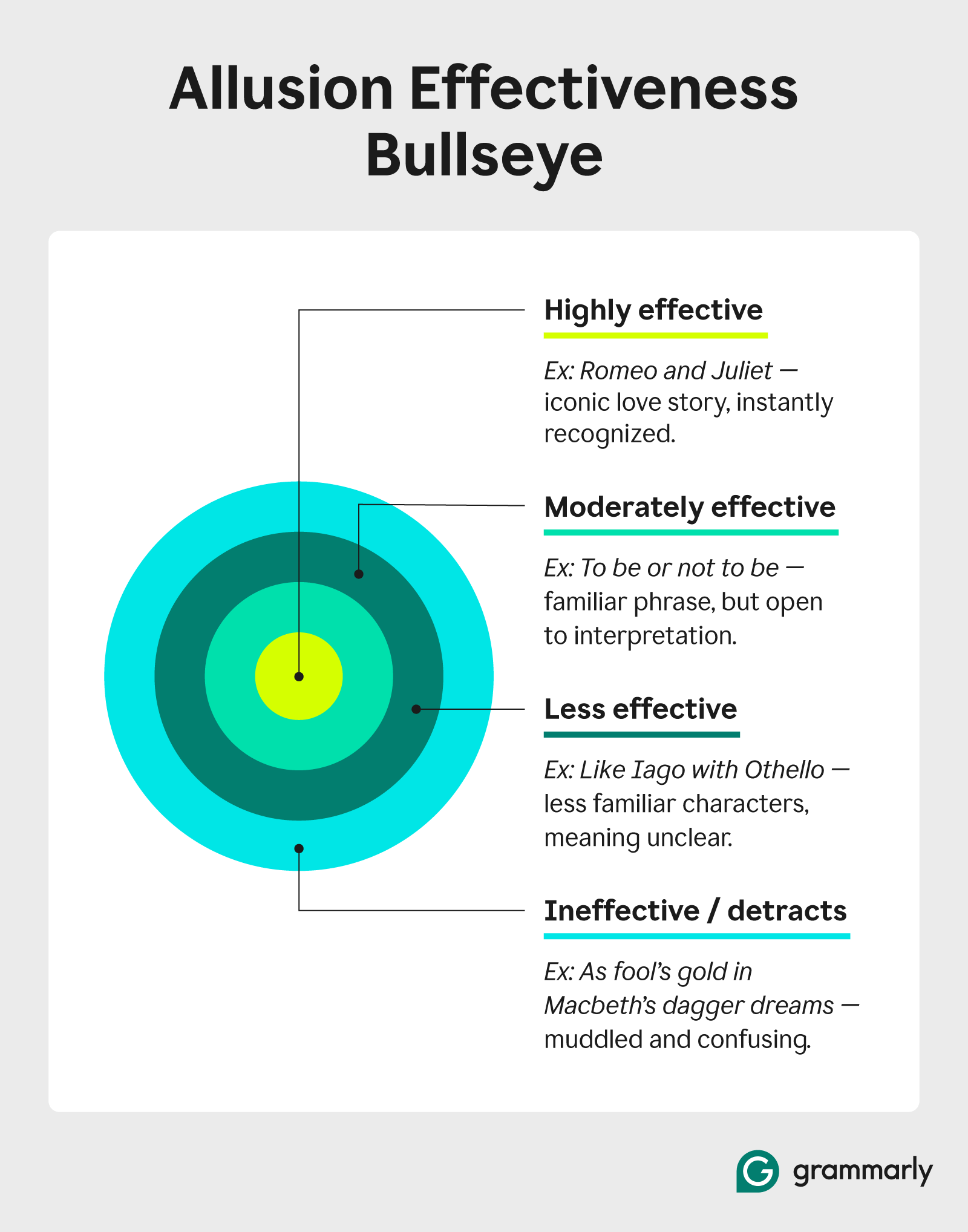
Key takeaways:
- Allusions are quick references to well-known things—books, movies, people, events—that add meaning without including extensive detail.
- Allusions make writing or speech more powerful, relatable, and emotional by connecting to shared knowledge.
- Examples of allusions include “Achilles’ heel” (a fatal weakness) or “Waterloo” (a decisive defeat).
Have you ever heard someone say they went “down the rabbit hole” online? That’s an allusion to Lewis Carroll’s Alice’s Adventures in Wonderland, where Alice follows a rabbit into a strange, unpredictable world. Today, the phrase refers to getting lost in a topic or activity, especially online.
An allusion is when we mention an object or idea that refers to something else, like a book or movie, without fully explaining it or mentioning the source, allowing the audience or reader to make the connection themselves. In this guide, we’ll explore how allusions work, share examples, and show you how to use them to strengthen your writing.
Table of contents
What is an allusion, and why do writers use them?
Allusion vs. other literary devices
What are examples of allusion?
How to use allusion in writing
What is an allusion, and why do writers use it?
An allusion is a literary device used to refer to something well-known, like a famous person, story, place, or event, without saying it explicitly, allowing the audience to glean the meaning and recognize the reference themselves. It’s a quick way to add extra meaning or feeling to what you’re saying or writing without spelling it out.
However, what’s considered “well-known” can vary across cultures, backgrounds, and generations. Many common English language allusions come from Western culture, such as Greek mythology, Shakespeare, the Bible, and Western history. Allusions are most effective when there’s a shared understanding within a specific audience.
Common English-speaking allusions include:
- Pandora’s box: In Greek mythology, Pandora opened a box that released all the world’s evils. “Pandora’s box” is an allusion to this myth and is used to warn against starting something that might lead to unforeseen problems.
- The Midas touch: King Midas turned everything he touched into gold, which became a curse. This phrase, which alludes to the story of the king, describes someone who seems to succeed in everything they do, often effortlessly.
- The Labyrinth: The labyrinth was a complex maze created to imprison the Minotaur. When you mention “the Labyrinth,” you’re alluding to this story to describe a confusing or difficult situation that’s hard to navigate.
You often see allusions used in books, stories, and creative nonfiction to make them more interesting or to add a hidden layer of meaning.
Types of allusion
Allusions come in different forms, each adding something unique to a piece of writing. From quick cultural references to creative twists on familiar stories, here are the main types of allusions and how to use them.
Casual allusion
A casual allusion is a brief, nonessential reference that adds flavor without altering conventional understanding of the concept. It creates a subtle connection or shared insight with the reader.
| Example | Context | Explanation |
| “He’s always chasing windmills.” | This is an allusion to Don Quixote, a fictional character who mistakes windmills for giants in the novel Don Quixote, by Miguel de Cervantes. | This allusion to Don Quixote describes an unrealistic idealist pursuing futile or unattainable goals. |
Self-reference
Self-reference, also called self-allusion, refers to an author’s previous works. It strengthens continuity and adds layers of meaning for readers familiar with the author’s work.
- Mentioning a past event from an earlier book
- Opening with a quote from an earlier work
- Reintroducing a recurring character
| Example | Context | Explanation |
| Stephen King’s “Ka” and the number 19 | This is an allusion to King’s larger body of work, in which he often weaves in “Ka” (meaning “destiny”) and the number 19, all tying back to The Dark Tower series. | These repeated hints create a shared universe, rewarding readers who follow his broader body of work. |
Corrective allusion
A corrective allusion directly opposes the common understanding of the source, offering a contrasting perspective.
| Example | Context | Explanation |
| “The new scholarship fund is a quiet Robin Hood—redirecting resources to where they’re needed most.” | Robin Hood is traditionally portrayed as a hero who steals from the rich to give to the poor. | This allusion reframes Robin Hood as a disruptor whose thefts challenge social order rather than acting just as charity. |
Single reference
A single, clear allusion is meant to be understood in context. It adds nuance, humor, or emotional weight without becoming symbolic or recurring.
| Example | Context | Explanation |
| “It’s a Trojan horse.” | The Trojan horse is a trick from Greek mythology where the Greeks hid inside a wooden horse to sneak into Troy. | This allusion to Greek myth describes something that’s hiding its true purpose, often a sneaky or deceptive plan. |
Multiple references
Multiple references involve several layered allusions from the same cultural or genre source. When done well, this form of allusion adds richness or humor by weaving together different references.
| Example | Context | Explanation |
| “Only the true king could pull the blade from the stone.” | Arthurian legend includes symbols like Excalibur (the sword) and Arthur (the true king). | The mention of these objects adds depth to the text by alluding to the King Arthur legend, which carries themes of destiny and heroism. |
Apparent allusion
An apparent allusion makes a specific reference to challenge its underlying message, prompting critical thinking.
| Example | Context | Explanation |
| “Like Romeo and Juliet, they thought it was love—but it was really just chaos in disguise.” | Romeo and Juliet, Shakespeare’s tragic play, tells of two young lovers whose relationship ends in death. | This allusion turns the classic love story on its head, showing how impulsive and unhealthy their relationship really was. |
Historical allusion
Historical allusions reference events, figures, or periods from history to deepen meaning or provide context in a modern scenario.
| Example | Context | Explanation |
| “The end of his corporate reign was like the fall of Babylon.” | A rapid downfall is being compared to the historic collapse of the ancient city of Babylon. | This allusion invokes the famous historical event of Babylon’s fall, symbolizing a dramatic and sudden collapse, often implying a loss of power or influence. |
Religious allusion
Religious allusions reference figures, stories, or concepts from religious texts or traditions to communicate a deeper moral or lesson.
| Example | Context | Explanation |
| “Turning the other cheek” | This phrase, derived from the Bible, is used to describe responding to aggression or insult with forgiveness instead of retaliation. | The allusion invokes Jesus’s teachings from the Sermon on the Mount, encouraging nonviolence and compassion in the face of conflict. |
Literary allusion
Literary allusions reference works, characters, or themes to enrich understanding or highlight particular ideas.
| Example | Context | Explanation |
| “We Frankenstein-ed together the various pieces until they resembled a whole.” | In Mary Shelley’s Frankenstein, Dr. Frankenstein puts together different body parts in hopes of creating a human, but ends up creating a monster. | This allusion to Shelley’s story describes creating something from separate, potentially mismatched components. |
Mythological allusion
Mythological allusions invoke characters, themes, or stories from mythology to reflect deeper truths or commentary on human nature.
| Example | Context | Explanation |
| Icarus’s flight has been reframed as reckless, not brave.
“When she attempted that triple back flip after a split leap, she was like Icarus flying too close to the sun.” |
Icarus, from Greek mythology, flies too close to the sun, causing his wings to melt. | This example alludes to the myth of Icarus to comment on the gymnast’s reckless hubris. |
Cultural allusion
Cultural allusions are references to shared cultural elements—such as movies, music, or art—that evoke familiar ideas or themes within a specific culture.
| Example | Context | Explanation |
| “Make them an offer they can’t refuse.” | This quote from The Godfather is used to satirize corporate manipulation or strong-arm tactics. | The allusion to this iconic Godfather line evokes themes of power and coercion in business, highlighting how offers can feel like ultimatums. |
Allusion vs. other literary devices
Allusions are often mistaken for other literary devices, but each serves a unique purpose. While allusions reference something familiar to add meaning, other devices use different techniques to convey ideas or create imagery. Here’s how they compare.
Metaphor
A metaphor explains an idea by directly stating that one thing is another, encouraging the reader to think about how the two things are alike. For example, when we say, “Time is a thief,” we suggest that time steals moments from us.
Unlike allusions, which reference something indirectly, metaphors draw a direct comparison. For example, saying someone has the “Midas touch” (alluding to the king who turned everything to gold) isn’t a metaphor—it’s an allusion to a familiar story. A metaphor would be saying, “He is King Midas,” directly comparing the person to the mythological figure.
Allegory
An allegory is a full narrative representing an idea or theme more broadly. In Animal Farm, George Orwell uses farm animals to symbolize political figures and systems.
Allusions, on the other hand, are brief and don’t require a complete story to be impactful. Instead, they simply reference something familiar, like when we say, “It’s a brave new world,” alluding to Aldous Huxley’s dystopian novel without fully explaining it.
Irony
Irony occurs when the intended meaning is the opposite of what’s said, often for humor or effect. For example, if someone calls a stormy day “perfect for a picnic,” it’s ironic because it’s actually not a good day to eat outside. In contrast, an allusion doesn’t flip meanings but relies on shared cultural or literary references.
For instance, saying “it’s a catch-22” alludes to Joseph Heller’s novel and implies a no-win situation without offering any reversal.
Personification
Personification gives human traits to nonhuman things. For example, when we say, “The wind whispered through the trees,” we attribute humanlike qualities to the wind. Allusions don’t do this. Instead, they reference something familiar to bring in extra meaning.
For instance, describing someone’s success as “hitting a home run” alludes to baseball, suggesting a great achievement or accomplishment without personifying the action.
What are examples of allusion?
Allusions appear in various forms of media, from literature to politics. Referencing familiar stories, figures, or events deepens meaning and creates connections with the audience. Here are some allusion examples from different categories:
Literature
In literature, allusions often tie characters, themes, or plots to well-known stories or historical events to enhance the message.
- East of Eden, by John Steinbeck: The brothers Cal and Aron Trask allude to the biblical figures Cain and Abel—sons of Adam and Eve—whose story centers on sibling rivalry, jealousy, and the struggle between good and evil.
- The Hunger Games, by Suzanne Collins: When Katniss volunteers for the deadly arena, it alludes to Roman gladiatorial games—public fights used to entertain and control—highlighting society’s desensitization to violence.
- The Fault in Our Stars, by John Green: When Hazel reflects on her illness, it alludes to Shakespeare’s play Julius Caesar, in which Cassius says, “The fault … is not in our stars, but in ourselves,” highlighting themes of fate, tragedy, and the limits of control.
Film and television
In films and TV shows, allusions can add depth to stories by invoking other films, historical events, or cultural concepts.
- Barbie (2023): This film incorporates elements that allude to The Matrix, 2001: A Space Odyssey, and feminist theory to explore identity and societal roles.
- Succession (2018–2023): This TV series draws parallels with Shakespearean tragedies like King Lear and Macbeth, reflecting themes of power, betrayal, and ambition.
- Stranger Things (2016–): This series nods to 1980s pop culture, Dungeons & Dragons, and Cold War fears, blending nostalgia with social commentary.
Politics
Allusions in politics often invoke historical figures, literature, or past events to make a point or inspire action.
- “Orwellian policies”: This critique refers to Orwell’s Nineteen Eighty-Four, implying oppression, surveillance, and totalitarianism.
- Campaigns quoting Hamilton: Politicians use lines like “I’m not throwing away my shot” to inspire civic engagement and revolutionary ideals.
- Martin Luther King Jr.’s “I Have a Dream” speech: “Five score years ago …” references Lincoln’s Gettysburg Address, linking the civil rights movement to the legacy of emancipation.
How to use allusion in writing
Allusion is a writing tool that connects your work to familiar stories, people, or events, adding depth and meaning. It allows you to create emotional connections and enrich the context by bringing to mind things your audience already knows.
Use the bull’s-eye below to gauge how effective your allusions are and aim for the center to make the strongest impact on your audience.

To use allusion well, know your audience and ensure your references strengthen your message without causing confusion. Here are key tips for using allusion in your writing:
Know your readers
Choose references your readers will recognize. Otherwise, the allusion will be lost on them, defeating its purpose.
For instance, in a blog post about tech integration in the restaurant industry, an allusion like “86 long waits with this dynamic new booking software” works well because restaurant professionals understand that “86” means an item is unavailable. This allows them to quickly infer that long waits will no longer be a problem for their business.
However, readers unfamiliar with restaurant jargon might need to research or infer the meaning, diluting the allusion’s intended impact.
Plot out the allusion
Plan where to place your allusions—like at the beginning, in headers, or during important moments—to make them more effective. Timing is key; use them to emphasize themes or create a stronger impact, but don’t overdo it. Keep a good balance to maintain the reader’s interest.
Show, don’t tell
Allusion effectively shows, rather than tells, key story elements. After drafting, consider replacing descriptions with stronger allusions. For example, instead of describing a wide smile, you might write “Cheshire Cat smile” or replace a description of a secluded headquarters with “the Batcave.”
Add depth to your writing through allusion
Literary devices like allusions enrich your writing by connecting to things readers already know. However, spelling and grammar mistakes can weaken its power. To make sure your allusions truly engage your readers, your writing needs to be clear and polished.
Make your next writing project a slam dunk
Allusion can elevate your writing, but clarity is key. Grammarly helps refine your grammar, spelling, and tone to help construct effective allusions. Try Grammarly for free!
Allusion FAQs
Below are frequently asked questions about allusion, a writing technique where authors reference familiar stories, events, or people to add meaning and interest.
When should you use allusion in your writing?
Allusion is a useful technique for writers for several reasons:
- Adds depth and context to your writing
- Enhances characterization
- Makes your writing (and you, as the author) more relatable
- Establishes you as an authority
When should you avoid using allusion in writing?
You should avoid allusions in technical writing, where the goal is to be:
- Clear
- Accurate
- Easy to understand
Using references to well-known people, stories, or events could confuse readers who aren’t familiar with them. In these cases, using simple, direct language to communicate the message is better.
Why do authors use allusions?
Authors use allusions to deepen meaning and connect to well-known stories, events, or cultural references. It enriches a text without lengthy explanations, engaging readers and encouraging them to think critically.
What are some synonyms for allusion?
The most accurate synonym for allusion is reference, especially in literary or rhetorical contexts. Other words with similar meanings include:
- Implication: Something hinted at
- Inference: A conclusion drawn indirectly
- Suggestion: A subtle or indirect mention
- Hint: A brief or subtle clue
- Mention: A passing reference
While these words are related, allusion refers to an indirect mention of something well-known, like a book, event, or person.






